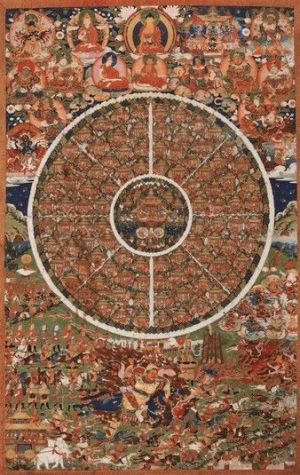Beyul
[[File:Guru Padmasambhava.jpg|thumb|250px|Padmasambhava)]
Beyul are hidden valleys, encompassing hundreds of square kilometers, which Padmasambhava blessed as refuges in the Nyingmapa Tibetan Buddhist beliefs. Terton may reveal them from terma at specific and appropriate times. Their locations were kept on scrolls (lamyig or neyig) hidden under rocks and inside caves, monasteries and stupas. Padmasambhava assigned deities to protect beyul. Protective forces manifest as snowstorms, mists and snow leopards. Buddhist texts indicate the beyul are discovered when the planet is approaching destruction and the world becomes too corrupt for spiritual practice. They describe valleys reminiscent of paradise, which can only be reached with enormous
hardship. Pilgrims who travel to these wild and distant places often recount extraordinary experiences similar to those encountered by Buddhist spiritual practitioners on the path to Liberation. People who try to force their way in, may encounter failure and death. Beyul retreat time has concentrated benefits. The places originate from a faith which has traditional natural site respect. Life in beyul is sacred and protected. Earthly beyuls share significant characteristics with Shambhala, which is the greatest hidden valley.
Guru Padmasambhava forecasted beyul while in the presence of Tibetan King Trisong Detsen and others at Samye Monastery :– “in the future when there will be warfare, strife, and difficult circumstances in the world, good people and dharma practitioners should travel to ‘Beyuls’ or hidden valleys situated south of the Tibetan Himalayan range for refuge.”
In Buddhism, sacred environments are places to deeply enter the world, and to avoid escaping it. The qualities inherent in such places reveal the interconnectedness of all life and deepen awareness of the spirit and mind's hidden regions. Visiting beyul with good motivation and appropriate merit, the pilgrim can learn to see the world differently from the way it commonly appears, developing and enhancing the Buddhist virtues of wisdom and compassion. Inside beyul, people should abandon their negative actions. The lands embody protector deities and lords of the land, which are associated with the geographic features such as mountain, trees, rocks and water sources. In custom, ritual offerings are made to these spirits to appease their wrathful nature and with the symbolic unity that people share with them. The attitude affords a sustainable approach toward land stewardship.
In Nepal and Tibet, around Mount Everest, are the Khenbalung, Solukhumbu, Rolwaling, Rongshar, Kyirong and Nubri www.nubri.org sacred valleys. The Sherpa people discovered Solukhumbu when they left Tibet to escape religious persecution in the 15th and 16th centuries. They entered the valley to seek refuge and made a new homeland there. Buddhist monasteries and sacred mountains have brought many spiritual travelers to Solukhumbu. Traditional beyul are found in the Himalayan regions of Nepal, Tibet, Sikkim, Bhutan, India, China and Pakistan.
